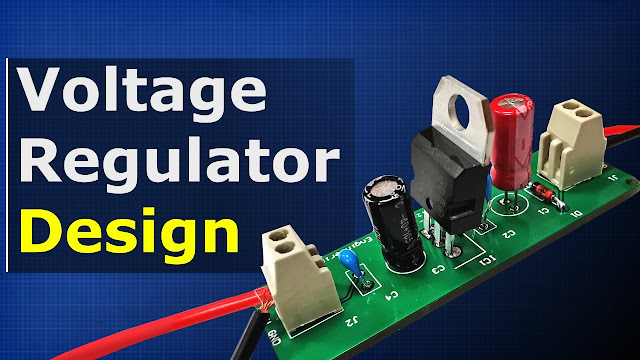on video 5V Regulator design tutorial - How it works, how to design PCB altium
Voltage regulator. Learn how to make a 5V regulator using capacitors, LM7805 regulator and Schottky diode, learn how the circuit works and also how to build your own PCB printed circuit board, how to order a PCB and how to solder the boards electronic components together.
Scroll to the bottom to watch the YouTube tutorial
This is what happens when we supply a lot of voltage to our electronic components.
A voltage regulator. And we're going to show you how it works, how to design one and even turn it into a fully working, professional looking printed circuit board to use as a power supply and even charge a phone with it. You can even download a copy of our circuit board too HERE.
Designing the Circuit
The purpose of a voltage regulator is to keep a constant output voltage, even when the input voltage changes. Why is that important? Because the electronic components are only rated to handle a certain voltage
Take this LED for example, if we connect it to a 9 volt battery, it will instantly be destroyed forever. That's because of this thin wire inside the LED. Looking under a microscope we can see the voltage pushed too many electrons through the wire which caused it to burn out. To protect the LED we need a resistor. This will reduce the current.
This is only a 10 ohm resistor, which is connected to our variable DC power supply. When we supply a small voltage, we see the LED is fine but as we increase this, the resistor burns into flames and the LED will be destroyed. So, using a resistor works well but the voltage must remain fairly constant. We therefore need a way to ensure a constant output voltage even when the input voltage is varied. Let's say we want to maintain a constant 5 volt DC supply and enough current to charge a simple cheap phone. We want to be able to connect this to multiple voltage sources such as 9 volts or maybe 12 volt batteries. To achieve that we need to use an integrated circuit component. There are lots to choose from, which can all work at different voltages, but from a bit of research we found this one. The LM7805.
Voltage regulator. Learn how to make a 5V regulator using capacitors, LM7805 regulator and Schottky diode, learn how the circuit works and also how to build your own PCB printed circuit board, how to order a PCB and how to solder the boards electronic components together.
Scroll to the bottom to watch the YouTube tutorial
This is what happens when we supply a lot of voltage to our electronic components.
A voltage regulator. And we're going to show you how it works, how to design one and even turn it into a fully working, professional looking printed circuit board to use as a power supply and even charge a phone with it. You can even download a copy of our circuit board too HERE.
Designing the Circuit
The purpose of a voltage regulator is to keep a constant output voltage, even when the input voltage changes. Why is that important? Because the electronic components are only rated to handle a certain voltage
Take this LED for example, if we connect it to a 9 volt battery, it will instantly be destroyed forever. That's because of this thin wire inside the LED. Looking under a microscope we can see the voltage pushed too many electrons through the wire which caused it to burn out. To protect the LED we need a resistor. This will reduce the current.
This is only a 10 ohm resistor, which is connected to our variable DC power supply. When we supply a small voltage, we see the LED is fine but as we increase this, the resistor burns into flames and the LED will be destroyed. So, using a resistor works well but the voltage must remain fairly constant. We therefore need a way to ensure a constant output voltage even when the input voltage is varied. Let's say we want to maintain a constant 5 volt DC supply and enough current to charge a simple cheap phone. We want to be able to connect this to multiple voltage sources such as 9 volts or maybe 12 volt batteries. To achieve that we need to use an integrated circuit component. There are lots to choose from, which can all work at different voltages, but from a bit of research we found this one. The LM7805.








No comments